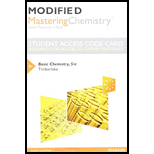
Concept explainers
(a)
Interpretation:
The total kilocalories corresponding to each meal needs to be determined.
Concept Introduction:
- Energy value or nutritional value of food is the amount of energy stored in 1 gram of the food material. It is expressed in terms of kcal/g or kJ/g
- The energy value varies across the food spectrum.
(a)
Answer to Problem 3.47FU
Breakfast = 270 kcal
Lunch = 420 kcal
Dinner = 440 kcal
Explanation of Solution
Breakfast:
Food consumed and the corresponding energy value:
1 Banana = 110 kcal
1 cup non-fat milk = 90 kcal
1 egg = 70 kcal
Total energy = 110 + 90 + 70 = 270 kcal
Lunch:
Food consumed and the corresponding energy value:
1 cup carrots = 50 kcal
3 oz grounded beef = 220 kcal
1 medium apple = 60 kcal
1 cup non-fat milk = 90 kcal
Total energy = 50 + 220 + 60 + 90 = 420 kcal
Dinner:
Food consumed and the corresponding energy value:
3 oz skinless chicken = 110 kcal
1 baked potato = 100 kcal
3 oz broccoli = 30 kcal
1 cup non-fat milk = 90 kcal
Total energy = 2(110) + 100 + 30 + 90 = 440 kcal
(b)
Interpretation:
The total kilocalories corresponding to each day needs to be determined.
Concept Introduction:
- Energy value or nutritional value of food is the amount of energy stored in 1 gram of the food material. It is expressed in terms of kcal/g or kJ/g.
- The energy value varies across the food spectrum.
(b)
Answer to Problem 3.47FU
Total energy per day = 1130 kcal
Explanation of Solution
Total energy for breakfast = 270 kcal
Total energy for lunch = 420 kcal
Total energy for dinner = 440 kcal
Total energy per day = 270 + 420 + 440 = 1130 kcal
(c)
Interpretation:
Whether Person C loses or gains weight needs to be determined based on the new diet.
Concept Introduction:
- Energy value or nutritional value of food is the amount of energy stored in 1 gram of the food material. It is expressed in terms of kcal/g or kJ/g
- The energy value varies across the food spectrum.
(c)
Answer to Problem 3.47FU
Person C will lose weight.
Explanation of Solution
It is given that Person C consumes 1800 kcal per day.However,based on the new diet, he will consume only 1130 kcal per. Since the new diet has a lower total calorie intake, it is likely that Person C will lose weight over time.
(d)
Interpretation:
The number of days taken by Person C in order to lose 5.0 lbs needs to be determined.
Concept Introduction:
- Energy value or nutritional value of food is the amount of energy stored in 1 gram of the food material. It is expressed in terms of kcal/g or kJ/g
- The energy value varies across the food spectrum.
(d)
Answer to Problem 3.47FU
Days taken to lose 5.0 lbs = 26 days
Explanation of Solution
Energy lost per day = 1800 -1130 = 670 kcal
Want to see more full solutions like this?
Chapter 3 Solutions
Modified Masteringchemistry With Pearson Etext -- Standalone Access Card -- For Basic Chemistry Format: Access Card Package
 ChemistryChemistryISBN:9781305957404Author:Steven S. Zumdahl, Susan A. Zumdahl, Donald J. DeCostePublisher:Cengage Learning
ChemistryChemistryISBN:9781305957404Author:Steven S. Zumdahl, Susan A. Zumdahl, Donald J. DeCostePublisher:Cengage Learning ChemistryChemistryISBN:9781259911156Author:Raymond Chang Dr., Jason Overby ProfessorPublisher:McGraw-Hill Education
ChemistryChemistryISBN:9781259911156Author:Raymond Chang Dr., Jason Overby ProfessorPublisher:McGraw-Hill Education Principles of Instrumental AnalysisChemistryISBN:9781305577213Author:Douglas A. Skoog, F. James Holler, Stanley R. CrouchPublisher:Cengage Learning
Principles of Instrumental AnalysisChemistryISBN:9781305577213Author:Douglas A. Skoog, F. James Holler, Stanley R. CrouchPublisher:Cengage Learning Organic ChemistryChemistryISBN:9780078021558Author:Janice Gorzynski Smith Dr.Publisher:McGraw-Hill Education
Organic ChemistryChemistryISBN:9780078021558Author:Janice Gorzynski Smith Dr.Publisher:McGraw-Hill Education Chemistry: Principles and ReactionsChemistryISBN:9781305079373Author:William L. Masterton, Cecile N. HurleyPublisher:Cengage Learning
Chemistry: Principles and ReactionsChemistryISBN:9781305079373Author:William L. Masterton, Cecile N. HurleyPublisher:Cengage Learning Elementary Principles of Chemical Processes, Bind...ChemistryISBN:9781118431221Author:Richard M. Felder, Ronald W. Rousseau, Lisa G. BullardPublisher:WILEY
Elementary Principles of Chemical Processes, Bind...ChemistryISBN:9781118431221Author:Richard M. Felder, Ronald W. Rousseau, Lisa G. BullardPublisher:WILEY





